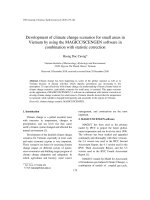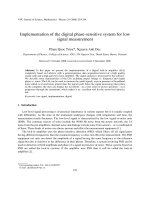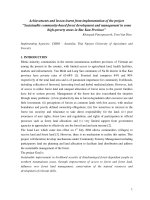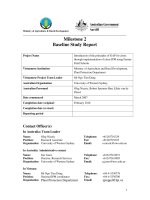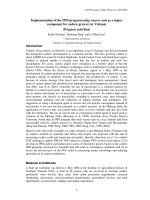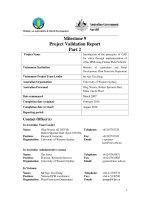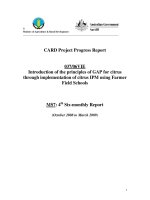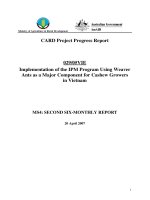Collaboration for Agriculture & Rural Development: " Implementation of the IPM program using weaver ants as a major component for cashew growers in Vietnam - MS3 " ppt
Bạn đang xem bản rút gọn của tài liệu. Xem và tải ngay bản đầy đủ của tài liệu tại đây (83.29 KB, 10 trang )
Ministry of Agriculture & Rural Development
Project Progress Report
029/05VIE
Implementation of the IPM program using weaver
ants as a major component for cashew growers in
Vietnam
MS3: FIRST SIX-MONTHLY REPORT
28 August 2006
1
Institute Information
Project Name
Implementation of the IPM program using weaver
ants as a major component for cashew growers in
Vietnam
Vietnamese Institution
Institute of Agricultural Science of South Vietnam
Vietnamese Project Team Leader
Professor Dr. Pham Van Bien
Australian Organisation
Charles Darwin University
Australian Personnel
Dr Keith Christian and Dr Renkang Peng
Date commenced
February 2006
Completion date (original)
January 2009
Completion date (revised)
Reporting period
February – August 2006
Contact Officer(s)
In Australia: Team Leader
Name:
Keith Christian
Telephone:
61 8 89466706
Position:
Associate Professor
Fax:
61 8 89466847
Organisation
Charles Darwin University
Email:
In Australia: Administrative contact
Name:
Jenny Carter
Telephone:
61 08 89466708
Position:
Research Manager
Fax:
61 8 89467199
Organisation
Charles Darwin University
Email:
In Vietnam
Name:
Pham Van Bien
Telephone:
84 8 8291746
Position:
Director
Fax:
84 8 8297650
Organisation
Institute of Agricultural Science
of South Vietnam
Email:
1
1. Project Abstract
Cashew is a very important crop in Vietnam, and the government has designated cashew
development as a national priority. Productivity of cashew has been increased since 2002, but
the extensive use of pesticides has caused health problems to farmers, their animals and the
environment. The cashew IPM program using weaver ants as a key component developed at
Charles Darwin University (CDU) does not use toxic insecticides, but results in high yield.
This project is to use the CDU cashew IPM to develop and implement a cashew IPM program
that will work under Vietnamese conditions. The proposed activities of the first 6 months
have been successfully achieved. The TOT training at two training centres has been operating
smoothly since July 2006. A total of 56 trainees from 8 main cashew-growing provinces have
participated in the TOT training. The results from field surveys of the TOT training have built
Vietnamese personnel confidence in the cashew IPM program. Two demonstration orchards
have been established. A baseline survey of pre-intervention of this project has been
successfully done. The development of the IPM curriculum and posters is in progress. High
control efficiency by crematogaster ants is a new finding of this project.
2. Executive Summary
The proposed activities for the first 6 months of the project have been successfully achieved.
The following are the summarised results against each of the activities.
Before starting the project, we held a pre-starting workshop to get comments and suggestions
on our project objectives, approaches, implementation methods and our training program
from local experts. The workshop was very successful, and our training program has been
revised accordingly.
We have identified 30 cashew-growing regions from 8 main cashew-growing provinces (two
more provinces than originally proposed) for the FFS training in 2007 based on the
suggestions and comments from provincial Sub-PPDs and Agricultural Services.
A total of 56 IPM trainers from 8 provinces have been undertaking the TOT training in two
training centres; 31 in the Binh Phuoc training centre and 25 in the Dong Nai centre. The
training has been operating smoothly since July 2006. Based on cashew tree phenology, the
first period of training concentrated on a baseline survey, effects of natural enemies on the
main cashew insect pests, and general cashew knowledge. Trainees were very interested in
the instructions and practicals. They were also satisfied with our training methods. The
trainees were fully convinced by the field data, either collected by course instructors or by
themselves, that weaver ants were very effective in controlling the most important cashew
pests of shoot borers and tea mosquito bugs, and the control levels were acceptable by
cashew farmers who participated in this training. It is concluded that the first session of TOT
training has built up trainees’ confidence in using weaver ants as a major component of the
cashew IPM program. A TOT training report is attached at the end of this report.
Two demonstration orchards have been established: one in Binh Phuoc province and the
other in Dong Nai province. Each orchard is 1.2 hectares, and is divided into two plots for
comparison purposes. One plot is being managed by the orchard owner with their normal
methods and the other plot by the project experimentalists using the IPM program.
2
Through extensive field surveys, observations and laboratory rearing, we have collected
sufficient data for the development of the cashew IPM curriculum for the cashew monsoon
flush period. A total of 175 photos have been obtained for the preparation of cashew IPM
posters.
It is worthwhile mentioning that in our field surveys, we found that cashew trees with
abundant crematogaster ants were much less damaged by the most important two pests than
trees with a few crametogaster ants or without ants or with black ants. This is a new finding
of this project.
A baseline survey was successfully conducted in eight main cashew growing provinces using
a standard questionnaire. The survey concentrated on the effect of current cashew husbandry
practices on the environment, assessment of cashew production, use of labour, pest and
disease practices and assessment of indigenous knowledge and practice with weaver ants.
The results are given in our baseline survey report.
3. Introduction & Background
The aims of this project are to increase cashew yield and improve nut quality. Specific
objectives are (1) to conduct TOT training in cashew IPM for TOT trainers to conduct FFSs
in their local region, (2) to develop an IPM cashew curriculum and a series of illustrative
posters that will work in Vietnamese conditions based on the cashew IPM programs
developed in Australia and (3) to assess the effectiveness of the FFS model in increasing
farmer knowledge and reducing pesticide use in cashew production.
The project expects to result in 120 TOT cashew IPM trainers from eight major cashew
provinces and 3750 cashew farmers educated in cashew FFSs. A practical guide for cashew
IPM and a series of illustrative posters will be developed. The effectiveness of FFS in
enhancing farmer knowledge in cashew cultivation will be assessed.
The project will concentrate on (1) the use of the farmer participatory training and research
program, involving TOT and FFSs and (2) the development of a cashew IPM curriculum and
illustrative posters based on field monitoring, observations and experiments by field
experimentalists, TOT trainees and FFS participants.
The implementation methods include establishment of demonstration orchards for TOT
courses, the TOT and FFS training, the development of a cashew IPM curriculum and IPM
posters, and the community baseline surveys. A total of 8 major cashew-growing provinces,
which have 300,700 ha of cashew, accounting for 86% of the total cashew in Vietnam will be
targeted.
4. Progress to Date
The following is the project progress against each of the proposed activities (in bold) of the
logframe of our project proposal.
4.1 Implementation Highlights
I (i) Identification of regions within each of the 6 participating provinces to be targeted
for the program
3
We have identified 30 cashew-growing regions, each of which consists of several villages,
from 8 main cashew growing provinces for the FFS training with the cashew IPM program
based on the suggestion and comments from provincial Sub-PPDs and Agricultural Services.
We have targeted two more provinces than we originally proposed.
I (ii) Selection of IPM trainers from each targeted region to undertake TOT training in
cashew IPM.
We have selected 56 IPM trainers from 8 sub-PPDs to undertake TOT training in cashew
IPM (see Table 1 for detail).
I (iii) TOT training in cashew IPM undertaken.
TOT training has been operating smoothly at two training centres since July 2006: Dong Nai
training centre having 25 trainees; and Binh Phuoc training centre having 31 trainees. The
TOT training involves a pre-starting workshop, the first period of TOT training and
establishment of demonstration orchards.
Pre-starting workshop
Before the opening of the training centres, we held a pre-starting workshop to have local
experts make comments and suggestions on our project objectives, approaches,
implementation methods and our training program. The workshop was held on 5 May 2006
at the campus of the Institute of Agricultural Science of Southern Vietnam. A total of 38
experts who are involved in Vietnam cashew production were invited, and they came from
plant protection departments, research institutions, universities, non-government
organizations, agricultural services and rural departments, an insecticide company and media
corporations (see Table 2 for detail). The main results from this workshop are summarised
below.
1. All participants expressed their interest in having the cashew IPM project for Vietnam
cashew small holders, and they said “this is the right time to implement this project
for cashew smallholders because of (1) the cashew nut price decreased by 35% in
2006, and farmers obtained very little profit due to their large costs towards
insecticides, fungicides and fertilizers, (2) some farmers are planning to cut cashew
trees for growing rubber trees due to the current high rubber price and (3) many
cashew smallholders are considering whether they will continue to grow cashews or
change to rubber.”.
2. The participants all agreed with our project objectives, expected outputs and approach
and methodology.
3. They made some useful comments and suggestions on our draft training program
based on problems they identified in the current cashew production and farmers’
requirements. The draft training program was revised and finalised accordingly (see
Table 3 for detail).
4. The activities of the workshop were fully reported by HCM City Television Station,
HCM City Broadcasting Corporation and the Agricultural News Paper of Vietnam.
First period of TOT training
The first period of TOT training was conducted from 12 to 18 July at Binh Phuoc training
centre and from 20 to 26 July at Dong Nai training centre. Trainees were very interested in
4
courses and practicals. They were satisfied with our training methods. The training
concentrated on three aspects: baseline survey, effects of natural enemies on the main cashew
insect pests, and general cashew knowledge (see Appendix 1 – Training report for detail).
The trainees were fully convinced by the field data collected, by course instructors or by
themselves in field practicals, showing that weaver ants were very effective in controlling the
most important cashew pests of shoot borers and tea mosquito bugs, and the control levels
were acceptable by cashew farmers who participated in this training. Therefore, the first
session of training has already built up trainees confidence in using weaver ants as a major
component of the cashew IPM program.
Establishment of demonstration orchards
Two field experimentalists are employed, and both have plant protection backgrounds with a
few years experience in cashew production. They are responsible for general management of
the IPM plots and weaver ant colonies, monitoring of the main insect pests in both IPM plot
and the farmer’s plots, sampling of the main insect pests and natural enemies, and help with
the TOT training.
Two demonstration orchards have been selected: one in Binh Phuoc province which is 15 km
away from the training centre; and the other in Dong Nai province which is 20 km away from
the centre. Each orchard is 1.2 hectares, containing 120 trees (3 – 4 years old), and is divided
into two plots. One plot has being managed by the orchard owner with their usual methods
and the other plot by the project experimentalists using the IPM program.
III. Cashew IPM curriculum development
III(i) Data collected from field surveys, monitoring, observations and experiments
conducted on TOT training orchards during the period of monsoon flush. Data analyses
and writing up.
Cashew trees have been either in dormancy or in monsoon leaf flush since the project started.
Baseline data of the insect pest assemblage and their damage were obtained. Regular
monitoring and sampling of insect pests and their natural enemies in the demonstration
orchards has begun. Because heavy rainfall in the wet season is one of the major factors
responsible for the reduction of weaver ant populations and the mortality of young ant
colonies, transplantation of weaver ant colonies into the IPM plots had to be delayed to
November.
Several field surveys and observations on the major insect pests and their natural enemies
(mainly weaver ants) in different types of cashew orchards were extensively conducted in
three provinces (Dong Nai, Ba Ria Vung Tau and Binh Phuoc). A total of 16 cashew insect
pest species and 18 species of natural enemies (predators, parasitoids and fungi) were found.
Among these, the most important insect pests were two species of shoot borers (one is
Alcides sp and the other is not identified yet) and the tea mosquito bug (Helopeltis antonii),
that caused the majority of damage on flushing shoots. The most important natural enemies
were weaver ants (Oecophylla smaragdina) and crametogaster ants (Crematogaster sp). The
effect of these two species of ants on cashew flushing shoots damaged by the three major
pests is shown in Table 4. Two points of interest emerge irrespective of provinces and types
of orchard. (1) The damage level on flushing shoots caused by shoot borers and tea mosquito
bugs was negligible on trees with weaver ants, and this level of damage is acceptable by
5
farmers. However, on trees without weaver ants or with black ants, 13-36 % of flushing
shoots were damaged by shoot borer and 6 – 24% by tea mosquito bugs. This difference is
highly significant. (2) Trees with abundant crematogaster ants were much less damaged by
these two pests than trees with a few crametogaster ants or without ants or with black ants
(Table 4). This is a new finding of this project. We will repeat these field surveys in other
cashew developmental stages to confirm the control efficiency of crematogaster ants. These
results will be included in the cashew IPM curriculum.
In addition to this, we have collected sufficient data from extensive field observations and
laboratory rearing for the following chapters of the cashew IPM curriculum during the period
of cashew monsoon flush:
- Cashew orchard management including weeding, fertilizing and pruning,
- Cashew breeding through grafting,
- The main cashew insect pests and diseases, and
- Common natural enemies.
IV. Cashew IPM poster development
IV(i) Photos, diagrams and graphs from field surveys, monitoring, observations and
experiments conducted on TOT training orchards in cashew monsoon flush.
A total of 175 photos have been obtained for the preparation of cashew IPM posters; 113 of
insect pests, 47 of natural enemies, 5 of diseases and 10 of orchard management. A detailed
selection of these photos will be made after we have comments and suggestions from TOT
trainees and farmers.
V. Effectiveness of the FFS in cashew IPM
V (i) Interviews with a randomly selected sub-set of farmers to assess pre-intervention
knowledge conducted
A baseline survey was successfully conducted in eight main cashew growing provinces using
a standard questionnaire. The survey concentrated on six aspects in relation to
• Current cashew husbandry practices, including the use of chemical pesticides and
fertilizers,
• Assessment of cashew production,
• Labour use and costs,
• Pest and disease practices and potential for improving environmental status, and
• Assessment of indigenous knowledge and practice with weaver ants.
The results of the baseline survey are shown in our Baseline Survey Report.
4.2 Smallholder Benefits
In our baseline survey, after explanation of what the cashew IPM program is, 97% of small
holders expressed their interest in this program and were keen to participate in FFS training.
Two issues have recently arisen with respect to current cashew production: (1) the cashew
nut price was decreased by 35% in 2006 compared to previous years, and farmers obtained
very little profit due to their large costs towards insecticides, fungicides and fertilizers, and
(2) some farmers were influenced by the current high rubber price, and they were at the
cross-road of deciding whether they need to switch from cashew to rubber. Farmers thought
6
that our IPM program will meet their requirements and it is the technology they are looking
for.
The baseline survey shows that pesticide spray has caused problems with the health of
farmers, their animals and the environment. This project which will not use toxic
insecticides, and will have direct benefits to farmers’ health and to the environment.
4.3 Capacity Building
Instead of having key Vietnamese personnel of this project come to Australia to have
extensive training of the weaver ant technology, Dr Peng went to Vietnam twice to work with
them to introduce various important parts of the ant technology. These included
establishment of IPM orchards, minoring and sampling methods, identification of weaver ant
colonies in the bush and the assessment of the ants on insect pest damage. They were all very
satisfied with his training. Now, they are able to manage the IPM orchards by themselves. In
November, Dr Peng will go to Vietnam again to demonstrate how to transfer weaver ant
colonies into cashew orchards and how to maintain the ant colonies.
4.4 Publicity
The project activities including the pre-starting workshop and TOT opening were fully
reported by HCM City Television Station, HCM City Broadcasting Corporation and the
Agricultural News Paper of Vietnam. AusAID logos have been displayed in all our activities.
4.5 Project Management
Associate Professor Keith Christian and Dr Renkang Peng are responsible for the overall
coordination of the project and will meet reporting requirements with input from Vietnamese
personnel as required. Dr Peng has been monitoring all the activities, and he is also
responsible for the implementation of the IPM program, for the part of the TOT training and
for the field data analyses. Dr Pham Van Bien and Mr La Pham Lan are in charge of
Vietnamese personnel and expenses of the project. Mr Lan is also responsible for Binh Phuoc
training centre and its demonstration orchard. IAS has recently authorized Mr Nguyen Thanh
Binh to be in charge of Dong Nai training centre and its demonstration orchard.
5. Report on Cross-Cutting Issues
5.1 Environment
In our baseline survey, 137 farmers made comments on the application of pesticides in their
own orchards, and 109 (80%) farmers had experienced various kinds of poison symptoms
during or after the insecticide operations, and they also mentioned that their animals, like
chicken and ducks, were affected. When farmers were asked whether the pesticide spray will
cause environmental problems, 181 (92%) out of 198 farmers said that pesticide spray had
already had adverse effects on the environment. In order to reduce this effect, they were all
keen to participate in our FFS training.
5.2 Gender and Social Issues
Based on our baseline survey, women already play a very important role in cashew
production. About 40% of labour was provided by women in orchard management, including
7
weeding, pruning, fertilizing, harvesting, etc Because the weaver ant technology is not
physically strenuous, and it does not involve toxic insecticide spray, its adoption could
further promote women’s participation in smallholder’s cashew production.
6. Implementation & Sustainability Issues
6.1 Issues and Constraints
Early in the program, project staff in CDU had communication problems with key
Vietnamese personnel, and this problem seems to have been resolved.
6.2 Options
Not applicable for this report.
6.3 Sustainability
Sustainability of cashew production in Vietnam is the focus of this project. All the objectives,
approaches, implementation methods and the training program are linked with this issue. In
our first period of TOT training, courses and practicals have already built up trainees’
confidence in using weaver ants as a major component to manage cashew orchards. This is a
significant step forward towards cashew production sustainability in the future.
7. Next Critical Steps
The following are our next critical activities for the next six-month period:
1. Complete establishment of demonstration orchards by transplanting weaver ant
colonies.
2. Continue the TOT training in the periods of monsoon flush, pre-flowering flush and
flowering and fruiting.
3. Collect data from field surveys, monitoring, observations and experiments conducted
in demonstration orchards in cashew pre-flowering and nut setting periods.
4. Analyse the data for the IPM curriculum development,
5. Take photos of insect pests, diseases and their natural enemies in the periods of pre-
flowering flush and flowering and fruiting for the IPM posters, and
6. Make diagrams and graphs from the results of field surveys, monitoring, observations
and experiments during the flowering and nut setting period for the IPM posters.
8. Conclusion
The proposed activities of the project for the first 6 months have been successfully achieved.
The pre-starting workshop was very successful. All Vietnamese experts agreed with our
project objectives, expected outputs and approach and methodology. We have revised our
training program based on the experts’ suggestions and comments.
A total of 30 cashew-growing regions have been identified from 8 main cashew-growing
provinces for the FFS training in 2007.
8
A total of 56 IPM trainers from 8 provinces have undertaken the TOT training in two training
centres: 31 in Binh Phuoc centre and 25 in Dong Nai centre. The training has been operating
smoothly since July 2006. Trainees were very interested in the courses and practicals, and
were satisfied with our training methods. All the TOT trainees were fully convinced with the
field data collected by course instructors and themselves that weaver ants are very effective
in controlling the most important cashew pests of shoot borers and tea mosquito bugs. This
has built-up trainees’ confidence in using weaver ants as a major component, which is a
significant step forward towards the rest of the TOT training.
Two demonstration orchards have been established: one in Binh Phuoc province and the
other in Dong Nai province. For comparison purposes, each orchard has been divided into
two plots. One plot is being managed by the orchard owner with their normal methods and
the other plot by the project experimentalists using the IPM program.
Sufficient data from extensive field surveys, observations and laboratory rearing were
obtained for the development of the cashew IPM curriculum for the period of cashew
monsoon flush. A total of 175 photos of the main insect pests, diseases, natural enemies and
cashew orchard management skills are ready for the preparation of cashew IPM posters. In
our field surveys, we found that cashew trees with abundant crematogaster ants were much
less damaged by the most important two pests than trees with a few crametogaster ants or
without ants or with black ants. This is a new finding of this project.
A baseline survey was successfully conducted in eight main cashew growing provinces with
a standard questionnaire. The survey concentrated on current cashew husbandry practices,
assessment of cashew production, labour use and costs, pest and disease practices and
assessment of indigenous knowledge and practices with weaver ants. The results are given in
our Baseline Survey Report.
The results of the first period of the TOT training is attached at the end of this report.
9

